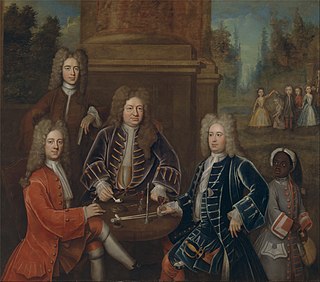
William Cavendish, 3rd Duke of Devonshire, was a British nobleman and Whig politician who sat in the House of Commons from 1721 to 1729 when he inherited the Dukedom.

Spencer Compton, 1st Earl of Wilmington, was a British Whig statesman who served continuously in government from 1715 until his death. He sat in the English and British House of Commons between 1698 and 1728, and was then raised to the peerage and sat in the House of Lords. He served as the Prime Minister from 1742 until his death in 1743. He is considered to have been Britain's second Prime Minister, after Sir Robert Walpole, but worked closely with the Secretary of State, Lord Carteret, in order to secure the support of the various factions making up the Government.

Lord James Cavendish FRS of Staveley Hall, Derbyshire was a British Whig politician who sat in the English House of Commons between 1701 and 1707 and in the British House of Commons between 1707 and 1742.
Robert Cowan was an Irish colonial administrator and the East India Company's Governor of Bombay from 1729 to 1734. He was a collateral ancestor of the Marquesses of Londonderry through the marriage of his sister, Mary Cowan, to Alexander Stewart, father of Robert Stewart, 1st Marquess of Londonderry.

Sir John Jennings was a Royal Navy officer and Whig politician who sat in the English and British House of Commons between 1705 and 1734. He commanded HMS Kent at Cadiz and Vigo in 1702 during the War of the Spanish Succession. He went on to be Commander-in-Chief of the Jamaica Station, then Senior Naval Lord and finally Governor of Greenwich Hospital.

George Chamberlayne, of Wardington Manor, Oxfordshire. and Hillesden, Buckinghamshire,.was a British politician who sat in the House of Commons from 1728 to 1747.
The Newfoundland Station was a formation or command of, first, the Kingdom of Great Britain and, then, of the United Kingdom's Royal Navy. Its official headquarters varied between Portsmouth or Plymouth in England where a squadron of ships would set sail annually each year to protect convoys and the British fishing fleet operating in waters off the Newfoundland coast and would remain for period of approximately six months based at St. John's Harbour. In 1818 the station became a permanent posting headquartered at St John's. It existed from 1729 to 1825.




